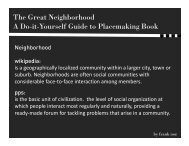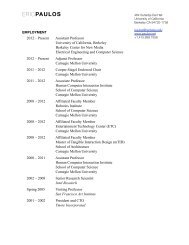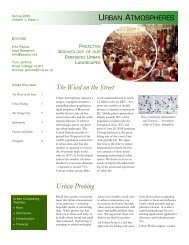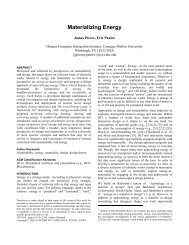Chapter 5: Modeling Users: Personas and Goals
Chapter 5: Modeling Users: Personas and Goals
Chapter 5: Modeling Users: Personas and Goals
You also want an ePaper? Increase the reach of your titles
YUMPU automatically turns print PDFs into web optimized ePapers that Google loves.
Part I: Underst<strong>and</strong>ing Goal-Directed Design<br />
description, along with a short,fietional paragraph describing the kind ofcar this<br />
person drives, how many kids he has, where he liv&", <strong>and</strong> what he does for a living.<br />
This kind of user profiJe is likely to be based on a stereotype <strong>and</strong> is not useful as a<br />
design tool. Although we give our personas names, <strong>and</strong> sometimes even cars <strong>and</strong><br />
family members, these are employed sparingly as narrative tools to help better<br />
communicate the real underlying data. Supporting fictional detail plays only the<br />
most minor part in persona creation <strong>and</strong> is used just enough to make the persona<br />
come to life in the minds of the designers <strong>and</strong> the product team.<br />
<strong>Personas</strong> versus market segments<br />
Marketing professionals may be familiar with a process similar to persona development<br />
because it shares some process similarities with market definition. The main<br />
difference between market segments <strong>and</strong> design personas is that the former are<br />
based on demographics, distribution channels, <strong>and</strong> purchasing behavior, whereas<br />
the latter are based on usage behavior <strong>and</strong> motivations. The two are not the same<br />
<strong>and</strong> don't serve the same purpose. Marketing personas shed light on the sales<br />
process, whereas design personas shed light on the product definition <strong>and</strong> development<br />
process.<br />
However, market segments playa role in persona development. They can help deter·<br />
mine the demographic range within which to frame the persona hypothesis (see<br />
<strong>Chapter</strong> 4). <strong>Personas</strong> are segmented along ranges ofusage behavior, not demographics<br />
or buying behavior, so there is seldom a one·to-one mapping ofmarket segments<br />
to personas. Rather, market segments can act as an initial filter to limit the scope of<br />
interviews to people within target markets (see Figure 5-3). Also, we typically use the<br />
prioritization ofpersonas as a way to make strategic product definition decisions (see<br />
the discussion of persona types later in this chapter). These decisions should incorporate<br />
market intelligence; an underst<strong>and</strong>ing of the relationship between user personas<br />
<strong>and</strong> market segments can be an important consideration here.<br />
When rigorous personas aren't possible:<br />
Provisional personas<br />
Although it is highly desirable that personas be based upon detailed qualitath~<br />
data, there are some occasions when there simply is not enough time, resources, or<br />
corporate buy-in to perform the necessary fieldwork. In these cases, provisionllo<br />
personas (or, as Don Norman refers to them, "ad hoc" personas) can be useful<br />
rhetorical tools to clearly communicate assumptions about who the importanf<br />
users are <strong>and</strong> what they need, <strong>and</strong> to enforce rigorous thinking about serving spe"<br />
cific user needs (even if these needs are not validated).<br />
Market J'<br />
'I<br />
Figure 5.3<br />
the Researc<br />
there is sek<br />
ProVisional<br />
data <strong>and</strong> de<br />
typically bas<br />
edge ofusen<br />
108 market,<br />
hypothesis (c<br />
Our experien<br />
yields better I<br />
~nas can hel<br />
tures <strong>and</strong> bel:<br />
this because tl<br />
qualitative dOlt<br />
Det learn, ifyo<br />
.. Focus<br />
.. FOCus,<br />
produc












